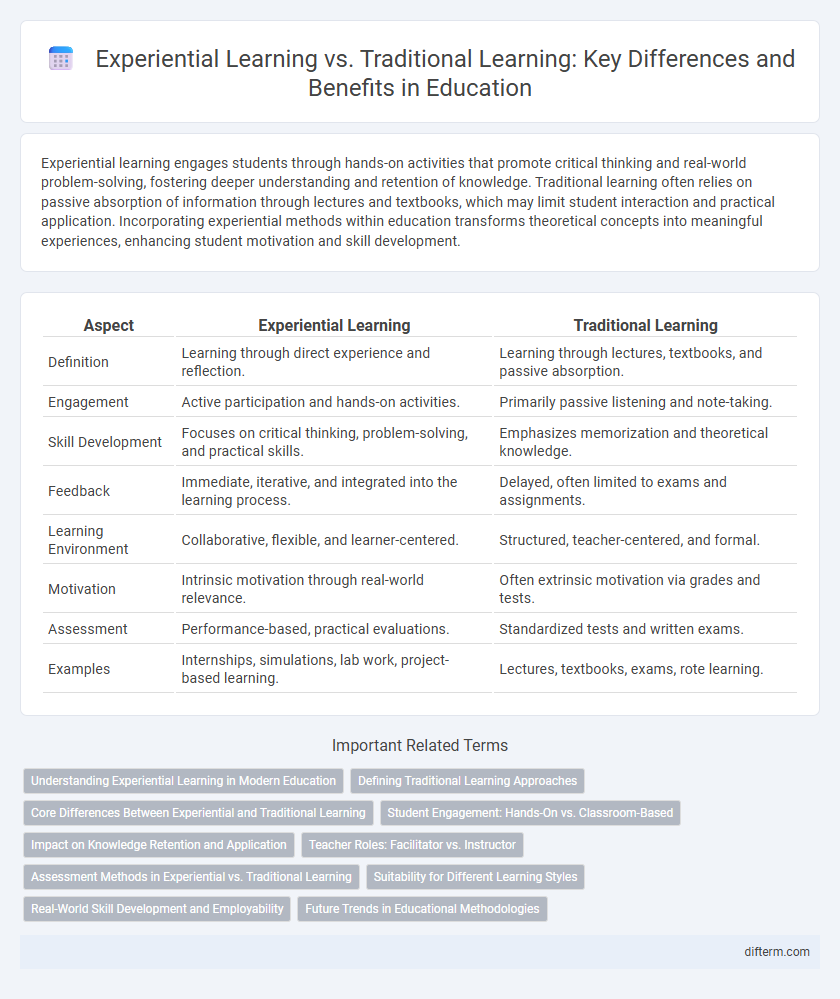Experiential learning engages students through hands-on activities that promote critical thinking and real-world problem-solving, fostering deeper understanding and retention of knowledge. Traditional learning often relies on passive absorption of information through lectures and textbooks, which may limit student interaction and practical application. Incorporating experiential methods within education transforms theoretical concepts into meaningful experiences, enhancing student motivation and skill development.
Table of Comparison
| Aspect | Experiential Learning | Traditional Learning |
|---|---|---|
| Definition | Learning through direct experience and reflection. | Learning through lectures, textbooks, and passive absorption. |
| Engagement | Active participation and hands-on activities. | Primarily passive listening and note-taking. |
| Skill Development | Focuses on critical thinking, problem-solving, and practical skills. | Emphasizes memorization and theoretical knowledge. |
| Feedback | Immediate, iterative, and integrated into the learning process. | Delayed, often limited to exams and assignments. |
| Learning Environment | Collaborative, flexible, and learner-centered. | Structured, teacher-centered, and formal. |
| Motivation | Intrinsic motivation through real-world relevance. | Often extrinsic motivation via grades and tests. |
| Assessment | Performance-based, practical evaluations. | Standardized tests and written exams. |
| Examples | Internships, simulations, lab work, project-based learning. | Lectures, textbooks, exams, rote learning. |
Understanding Experiential Learning in Modern Education
Experiential learning in modern education emphasizes active participation and real-world experience, allowing students to apply theoretical knowledge through hands-on activities and reflective practices. Unlike traditional learning, which relies heavily on lectures and rote memorization, experiential learning enhances critical thinking, problem-solving skills, and retention by engaging learners in meaningful tasks. Educational institutions incorporating project-based learning, internships, and collaborative workshops demonstrate significant improvements in student motivation and practical competency development.
Defining Traditional Learning Approaches
Traditional learning approaches typically emphasize structured, teacher-centered instruction where learners receive information through lectures, textbooks, and standardized assessments. This method prioritizes memorization, repetition, and the acquisition of theoretical knowledge over practical application. Classroom environments often follow rigid curricula designed to evaluate student performance primarily through exams and homework.
Core Differences Between Experiential and Traditional Learning
Experiential learning emphasizes hands-on, active participation, enabling students to apply concepts through real-world experiences and reflection, whereas traditional learning relies heavily on passive reception of information via lectures and textbooks. Core differences include the emphasis on critical thinking and problem-solving in experiential learning, contrasted with rote memorization and standardized testing typical in traditional methods. This approach fosters deeper understanding, adaptability, and retention compared to the often theory-focused, instructor-led traditional classroom environment.
Student Engagement: Hands-On vs. Classroom-Based
Experiential learning significantly enhances student engagement by providing hands-on activities that promote active participation and real-world problem-solving, contrasting with the passive reception commonly found in traditional classroom-based learning. Studies indicate that students involved in experiential methods demonstrate higher retention rates and improved critical thinking skills due to direct involvement with the material. This approach aligns with educational frameworks like Kolb's Experiential Learning Theory, emphasizing learning through experience rather than passive instruction.
Impact on Knowledge Retention and Application
Experiential learning significantly enhances knowledge retention by engaging students in hands-on activities that promote active participation and critical thinking, leading to deeper understanding compared to traditional lecture-based methods. This approach fosters practical application of concepts, enabling learners to transfer skills effectively to real-world situations, whereas traditional learning often emphasizes theoretical knowledge with limited opportunities for practice. Studies show that experiential learning increases retention rates by up to 75%, highlighting its impact on long-term educational outcomes.
Teacher Roles: Facilitator vs. Instructor
Experiential learning positions teachers as facilitators who guide students through hands-on activities and real-world problem-solving, fostering critical thinking and collaboration. In contrast, traditional learning emphasizes the instructor's role in delivering structured content and maintaining classroom control to ensure knowledge transmission. This shift from instructor-led to facilitator-oriented teaching enhances student engagement and promotes deeper understanding.
Assessment Methods in Experiential vs. Traditional Learning
Assessment methods in experiential learning emphasize performance-based evaluations such as portfolios, presentations, and real-world project outcomes, enabling students to demonstrate applied knowledge and critical thinking skills. Traditional learning primarily relies on standardized tests and written exams to measure memorization and theoretical understanding. Experiential assessments provide richer insights into student competencies by capturing practical problem-solving and reflective abilities often overlooked in conventional assessments.
Suitability for Different Learning Styles
Experiential learning caters to kinesthetic and interactive learners by engaging them in hands-on activities and real-world problem solving, enhancing retention and application of knowledge. Traditional learning suits auditory and visual learners through structured lectures and textbook-based instruction, providing clear frameworks and foundational understanding. Matching learning approaches to individual styles optimizes educational outcomes and student engagement across diverse classrooms.
Real-World Skill Development and Employability
Experiential learning fosters real-world skill development by immersing students in practical, hands-on experiences that mirror workplace challenges, enhancing critical thinking, problem-solving, and adaptability. Traditional learning often emphasizes theoretical knowledge, which may limit the immediate application of skills required in dynamic job markets. Employers increasingly value candidates with experiential learning backgrounds due to their demonstrated ability to navigate complex, real-world scenarios effectively, boosting employability.
Future Trends in Educational Methodologies
Experiential learning, emphasizing hands-on projects and real-world problem solving, is reshaping future educational methodologies by fostering critical thinking and adaptability skills. Traditional learning, centered on lectures and memorization, struggles to meet the demands of a rapidly evolving job market driven by technology and innovation. Emerging trends highlight a hybrid approach integrating virtual reality simulations and collaborative, experience-based curricula to prepare learners for complex, dynamic environments.
experiential learning vs traditional learning Infographic

 difterm.com
difterm.com